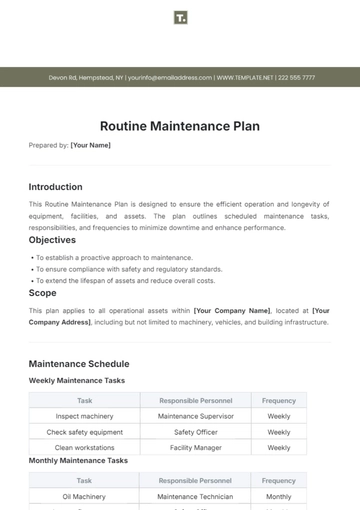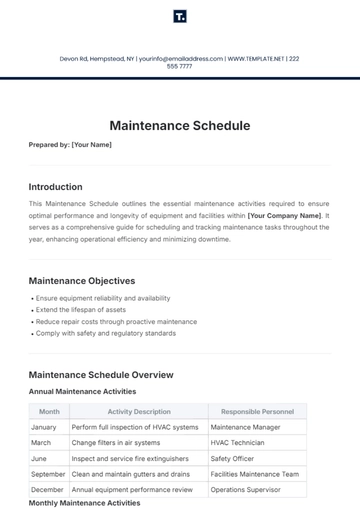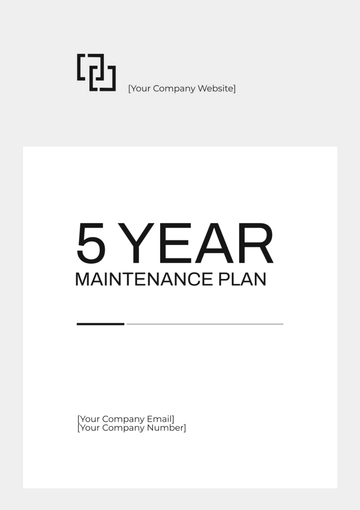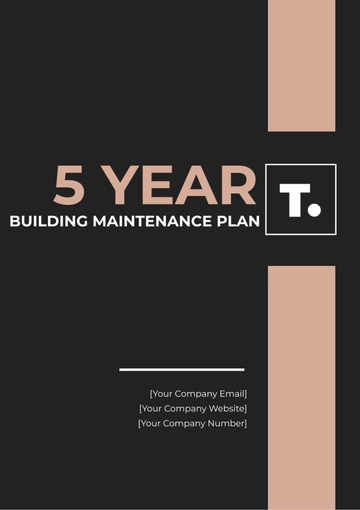Free 5 Year Maintenance Plan
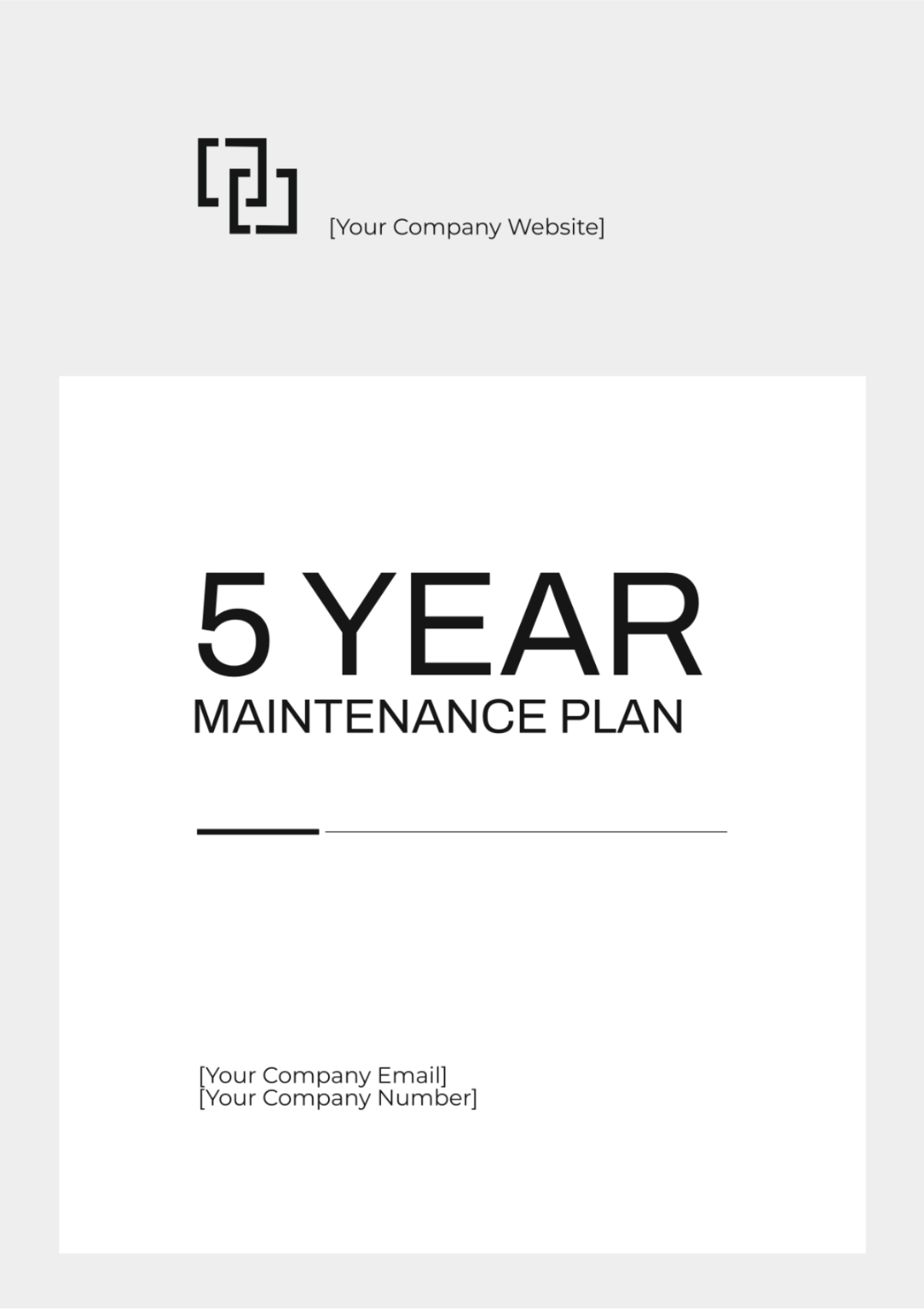
I. Introduction
A. Purpose
The purpose of this 5 Year Maintenance Plan is to outline a comprehensive schedule for the maintenance and upkeep of [YOUR COMPANY NAME]'s building to ensure its safety, functionality, and longevity.
B. Objectives
Safety and Comfort: Maintain a safe and comfortable environment for all occupants by addressing potential hazards and ensuring proper operation of building systems.
Structural Integrity: Preserve the building’s structural integrity through regular inspections and timely repairs.
Cost Optimization: Optimize maintenance costs through proactive planning and preventive maintenance to avoid expensive emergency repairs.
Regulatory Compliance: Comply with all relevant local, state, and federal regulations and standards to ensure legal and safety requirements are met.
II. Maintenance Schedule Overview
A. Annual Maintenance Tasks
HVAC System Inspection and Maintenance
Inspect and service HVAC units to ensure efficient operation.
Clean or replace filters to maintain air quality.
Check and calibrate thermostats for accurate temperature control.
Schedule: Annually in April.
Electrical System Inspection
Inspect wiring and electrical panels for wear and tear.
Test backup generators and emergency lighting systems to ensure they function during power outages.
Verify compliance with electrical codes and update any outdated systems.
Schedule: Annually in May.
Plumbing System Inspection
Check for leaks, corrosion, and proper operation of all plumbing fixtures.
Inspect water heaters and boilers for efficiency and safety.
Test water pressure and drainage systems to prevent clogs and backups.
Schedule: Annually in June.
Fire Safety Inspection
Test fire alarms, smoke detectors, and sprinkler systems to ensure they are operational.
Check and replace fire extinguishers as necessary.
Conduct fire drills and update emergency response plans.
Schedule: Annually in September.
B. Biannual Maintenance Tasks
Roof and Gutter Inspection
Inspect and clean gutters and downspouts to prevent water damage.
Check the roof for damage, leaks, and wear, making necessary repairs.
Ensure proper drainage to avoid standing water and potential structural damage.
Schedule: Biannually in March and October.
Exterior Maintenance
Inspect and repair exterior walls, windows, and doors for any signs of damage or wear.
Pressure wash exterior surfaces and repaint as needed to maintain appearance and protection.
Check for signs of pest infestation and take appropriate measures.
Schedule: Biannually in April and November.
III. Yearly Maintenance Plans
A. Year 1: Baseline Assessment and Immediate Repairs
Comprehensive Building Condition Assessment
Conduct a thorough inspection of the entire building to identify current conditions and immediate repair needs.
Document all findings and create a detailed report.
Address Immediate Repairs
Prioritize and complete repairs identified in the baseline assessment to prevent further damage or safety issues.
Inventory of Building Systems and Components
Establish a detailed inventory of all building systems (HVAC, electrical, plumbing, etc.) and components (windows, doors, fixtures, etc.).
Create a database to track maintenance history and upcoming tasks.
B. Year 2: Preventive Maintenance and Minor Upgrades
Preventive Maintenance Program Implementation
Develop and implement a preventive maintenance program based on Year 1 assessment findings.
Schedule regular inspections and maintenance tasks to prevent future issues.
Lighting System Upgrades
Upgrade lighting systems to energy-efficient LEDs to reduce energy consumption and maintenance costs.
Replace outdated fixtures and bulbs.
Safety Systems Inspection
Conduct a thorough inspection of all safety systems, including fire alarms, sprinkler systems, and emergency lighting.
Update and repair any components as needed to ensure full compliance and functionality.
C. Year 3: Mid-Term Improvements
Flooring Resurfacing or Replacement
Resurface or replace flooring in high-traffic areas to maintain appearance and safety.
Use durable materials to extend the lifespan of the flooring.
Insulation and Weatherproofing Inspection
Inspect and service the building’s insulation and weatherproofing to improve energy efficiency and occupant comfort.
Repair any gaps, leaks, or damaged insulation.
HVAC System Upgrades
Upgrade HVAC systems to newer, more energy-efficient models.
Implement smart thermostats and controls to optimize heating and cooling.
D. Year 4: Major Systems Overhaul
HVAC Units Replacement
Replace aging HVAC units that are no longer efficient or cost-effective to maintain.
Install high-efficiency units to reduce energy consumption and improve climate control.
Comprehensive Electrical System Upgrade
Perform a full upgrade of the electrical system to modern standards.
Replace outdated wiring, panels, and components to ensure safety and reliability.
Restroom and Common Area Renovations
Renovate restrooms and common areas to modern standards, improving aesthetics and functionality.
Install water-saving fixtures and durable, low-maintenance materials.
E. Year 5: Evaluation and Future Planning
Full Building Assessment
Conduct a full assessment of the building to evaluate the success of the maintenance plan.
Identify areas that need further attention or improvement.
Planning for the Next 5-Year Cycle
Based on the assessment, plan for the next 5-year maintenance cycle.
Update the maintenance plan to reflect current building conditions and future needs.
Updating Maintenance Records
Ensure all maintenance records are up-to-date and complete.
Adjust schedules and plans based on the latest assessment and historical data.
IV. Budgeting and Resource Allocation
A. Annual Budget Estimates
Year | Amount | Purpose |
|---|---|---|
Year 1 | $50,000 | Baseline assessment and immediate repairs |
Year 2 | $45,000 | Preventive maintenance and minor upgrades |
Year 3 | $60,000 | Mid-term improvements |
Year 4 | $80,000 | Major systems overhaul |
Year 5 | $55,000 | Evaluation and future planning |
B. Resource Allocation
Routine Maintenance Funds
Allocate sufficient funds each year for routine maintenance tasks such as inspections, cleaning, and minor repairs.
Contingency Fund
Set aside a contingency fund each year to cover unexpected repairs or emergencies.
Staff Training and Development
Invest in ongoing training and development for maintenance personnel to ensure they are equipped with the latest skills and knowledge.
V. Monitoring and Reporting
A. Regular Monitoring
Quarterly Inspections
Conduct quarterly inspections to identify and address maintenance issues promptly.
Generate detailed reports documenting the condition of building systems and components.
Computerized Maintenance Management System (CMMS)
Use a CMMS to track maintenance tasks, schedules, and progress.
Ensure all maintenance activities are logged and easily accessible for review.
Review and Adjust Plans
Regularly review inspection findings and adjust maintenance plans as necessary to address emerging issues.
B. Reporting
Annual Maintenance Reports
Provide detailed annual maintenance reports to [YOUR COMPANY NAME]'s management, outlining completed tasks, expenses, and upcoming plans.
Stakeholder Updates
Share maintenance updates and reports with stakeholders to ensure transparency and build trust.
Accountability
Ensure all maintenance activities are conducted with accountability and transparency to build confidence in the maintenance program.
VI. Conclusion
The implementation of this 5 Year Maintenance Plan will ensure that [YOUR COMPANY NAME] maintains a safe, efficient, and well-preserved building. Regular updates and adherence to this plan will help in achieving long-term operational success and asset longevity. By investing in preventive maintenance, timely repairs, and continuous improvements, we aim to provide a high-quality environment for all occupants and stakeholders.
- 100% Customizable, free editor
- Access 1 Million+ Templates, photo’s & graphics
- Download or share as a template
- Click and replace photos, graphics, text, backgrounds
- Resize, crop, AI write & more
- Access advanced editor
Ensure hassle-free operations with Template.net's 5 Year Maintenance Plan Template. This customizable and editable template is designed for efficiency and precision. Utilize our advanced AI Editor Tool to tailor the plan to your specific needs, saving time and resources. Perfect for maintaining top-notch performance, this template offers a streamlined approach to maintenance management.
You may also like
- Finance Plan
- Construction Plan
- Sales Plan
- Development Plan
- Career Plan
- Budget Plan
- HR Plan
- Education Plan
- Transition Plan
- Work Plan
- Training Plan
- Communication Plan
- Operation Plan
- Health And Safety Plan
- Strategy Plan
- Professional Development Plan
- Advertising Plan
- Risk Management Plan
- Restaurant Plan
- School Plan
- Nursing Home Patient Care Plan
- Nursing Care Plan
- Plan Event
- Startup Plan
- Social Media Plan
- Staffing Plan
- Annual Plan
- Content Plan
- Payment Plan
- Implementation Plan
- Hotel Plan
- Workout Plan
- Accounting Plan
- Campaign Plan
- Essay Plan
- 30 60 90 Day Plan
- Research Plan
- Recruitment Plan
- 90 Day Plan
- Quarterly Plan
- Emergency Plan
- 5 Year Plan
- Gym Plan
- Personal Plan
- IT and Software Plan
- Treatment Plan
- Real Estate Plan
- Law Firm Plan
- Healthcare Plan
- Improvement Plan
- Media Plan
- 5 Year Business Plan
- Learning Plan
- Marketing Campaign Plan
- Travel Agency Plan
- Cleaning Services Plan
- Interior Design Plan
- Performance Plan
- PR Plan
- Birth Plan
- Life Plan
- SEO Plan
- Disaster Recovery Plan
- Continuity Plan
- Launch Plan
- Legal Plan
- Behavior Plan
- Performance Improvement Plan
- Salon Plan
- Security Plan
- Security Management Plan
- Employee Development Plan
- Quality Plan
- Service Improvement Plan
- Growth Plan
- Incident Response Plan
- Basketball Plan
- Emergency Action Plan
- Product Launch Plan
- Spa Plan
- Employee Training Plan
- Data Analysis Plan
- Employee Action Plan
- Territory Plan
- Audit Plan
- Classroom Plan
- Activity Plan
- Parenting Plan
- Care Plan
- Project Execution Plan
- Exercise Plan
- Internship Plan
- Software Development Plan
- Continuous Improvement Plan
- Leave Plan
- 90 Day Sales Plan
- Advertising Agency Plan
- Employee Transition Plan
- Smart Action Plan
- Workplace Safety Plan
- Behavior Change Plan
- Contingency Plan
- Continuity of Operations Plan
- Health Plan
- Quality Control Plan
- Self Plan
- Sports Development Plan
- Change Management Plan
- Ecommerce Plan
- Personal Financial Plan
- Process Improvement Plan
- 30-60-90 Day Sales Plan
- Crisis Management Plan
- Engagement Plan
- Execution Plan
- Pandemic Plan
- Quality Assurance Plan
- Service Continuity Plan
- Agile Project Plan
- Fundraising Plan
- Job Transition Plan
- Asset Maintenance Plan
- Maintenance Plan
- Software Test Plan
- Staff Training and Development Plan
- 3 Year Plan
- Brand Activation Plan
- Release Plan
- Resource Plan
- Risk Mitigation Plan
- Teacher Plan
- 30 60 90 Day Plan for New Manager
- Food Safety Plan
- Food Truck Plan
- Hiring Plan
- Quality Management Plan
- Wellness Plan
- Behavior Intervention Plan
- Bonus Plan
- Investment Plan
- Maternity Leave Plan
- Pandemic Response Plan
- Succession Planning
- Coaching Plan
- Configuration Management Plan
- Remote Work Plan
- Self Care Plan
- Teaching Plan
- 100-Day Plan
- HACCP Plan
- Student Plan
- Sustainability Plan
- 30 60 90 Day Plan for Interview
- Access Plan
- Site Specific Safety Plan
